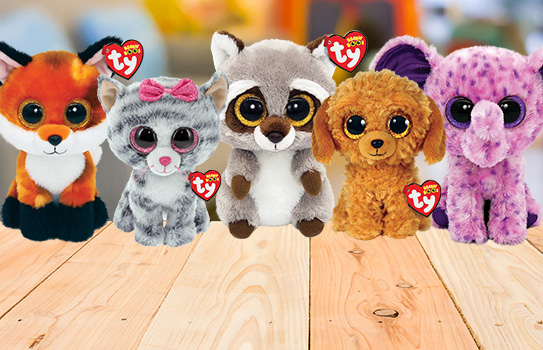This post was modified on July 24, 2025.
Have you ever wondered why stuffed animals with big eyes are so appealing? One of our most popular Ty product lines, sought after by parents and children alike, is our Beanie Boo line. Each plush Beanie Boo is characterized by large, sparkly, inquisitive eyes. So, why do we humans - adults and children - find the Boos’ big eyes utterly adorable? There’s some science behind why we love cute stuffed animals like Beanie Boos.
Imagine the cutest puppy, baby, or plush toy - maybe your favorite stuffed animal from your childhood. Now that you have a visual in your mind, what do all of these have in common?
You’re probably imagining a puppy with large begging eyes, a baby with wide, sweet eyes, or a doll or other toys with big eyes and a kind smile.
There’s a scientific reason for this association: Big eyes are empirically cuter and trigger caring instincts.
The Science Behind Cuteness
In the 1900s, Konrad Lorenz, a founder of ethology - the study of the behavior of animals - created the scientific term kindchenschema (infant schema). This infant schema, or baby schema, signifies that humans are drawn to infants with cute features, such as big eyes, a large head, a round face, chubby cheeks, and a small mouth and nose. This term also applies to infant sounds and smells associated with new babies.
Lorenz hypothesized that when humans find something adorable, they want to protect and care for it. People become caretakers, instinctively wanting to connect with and give the baby or small animal attention. The cuteness factor also motivates adults to be caring and protective, to bond with the infant, and to show empathy toward the infant.
More recently, in 2009, a study elaborating on Lorenz’s findings was conducted at Drexel University in Pennsylvania with a group of 122 students. These students were presented with a set of three images of an infant where the photos had been slightly modified to enhance the baby’s theoretical cuteness traits identified in kindchenschema. The study asked the students to rate each one of the photos, stating which of the three was the cutest. They also had to rate the photos on how willing they were to take care of the babies. The results of the study showed that the students were captivated by the altered images that mirrored Lorenz’s infant schema. These same babies were also chosen by the students as the ones that they would be more willing to take care of.
While this clearly demonstrates that Lorenz was onto something, the evolution of cuteness among species remains a mystery. Have you ever seen a photo of a bush baby, a type of small, huge-eyed primate from Africa? Other animals with large eyes centered include owls, ostriches, lemurs, dogs, and cats. Some animals, such as pandas, raccoons, and sloths, also have darker markings around their eyes, which give the impression of larger eyes. All of these animals are adored by humans and are frequently seen in popular culture.
Ty Stuffed Animals with Big Eyes
What are the stuffed animals with big eyes called? In the wild world of plush, Ty’s Beanie Boos are the kings and queens of cuteness with their big eyes and captivating colors. These big-eyed plush help instill caregiving and protective instincts in children of all ages as they play, pretend, and carry their Beanie Boos with them everywhere. Kids become attached to their stuffed animals with big eyes, and parents will absolutely love these plush Beanies too.
Find Our Latest Big-Eyed Stuffed Animals
Ty Beanie Boos come in a variety of plush animal favorites, including bears, unicorns, dogs, birds, dragons, cats, monkeys, cows, penguins, and more, from plush sea creatures to stuffed safari animals. Shop our website 24/7 for our latest big-eyed stuffed animals.

